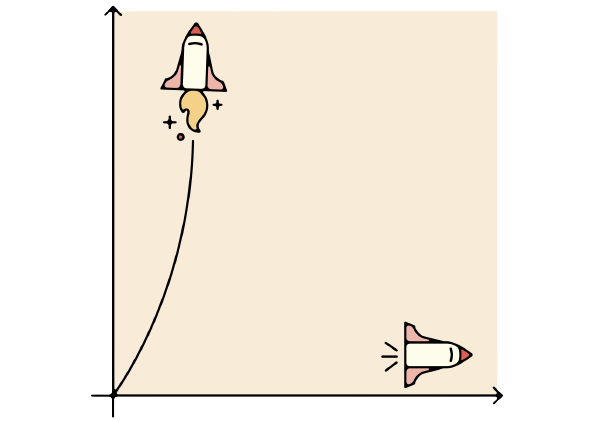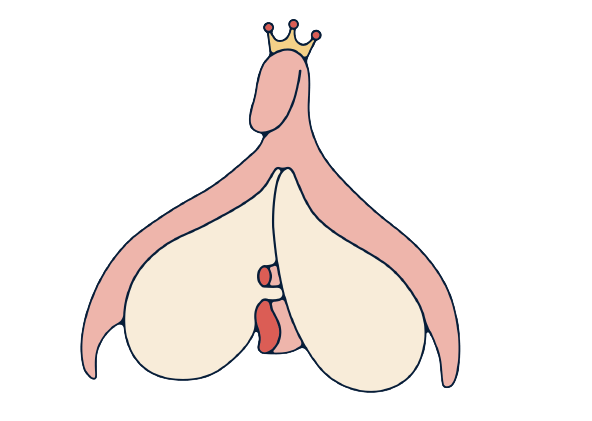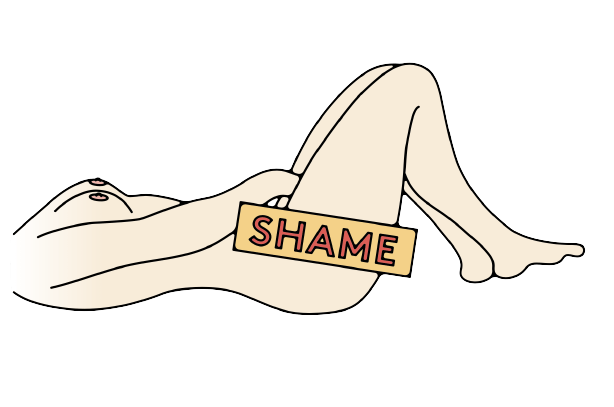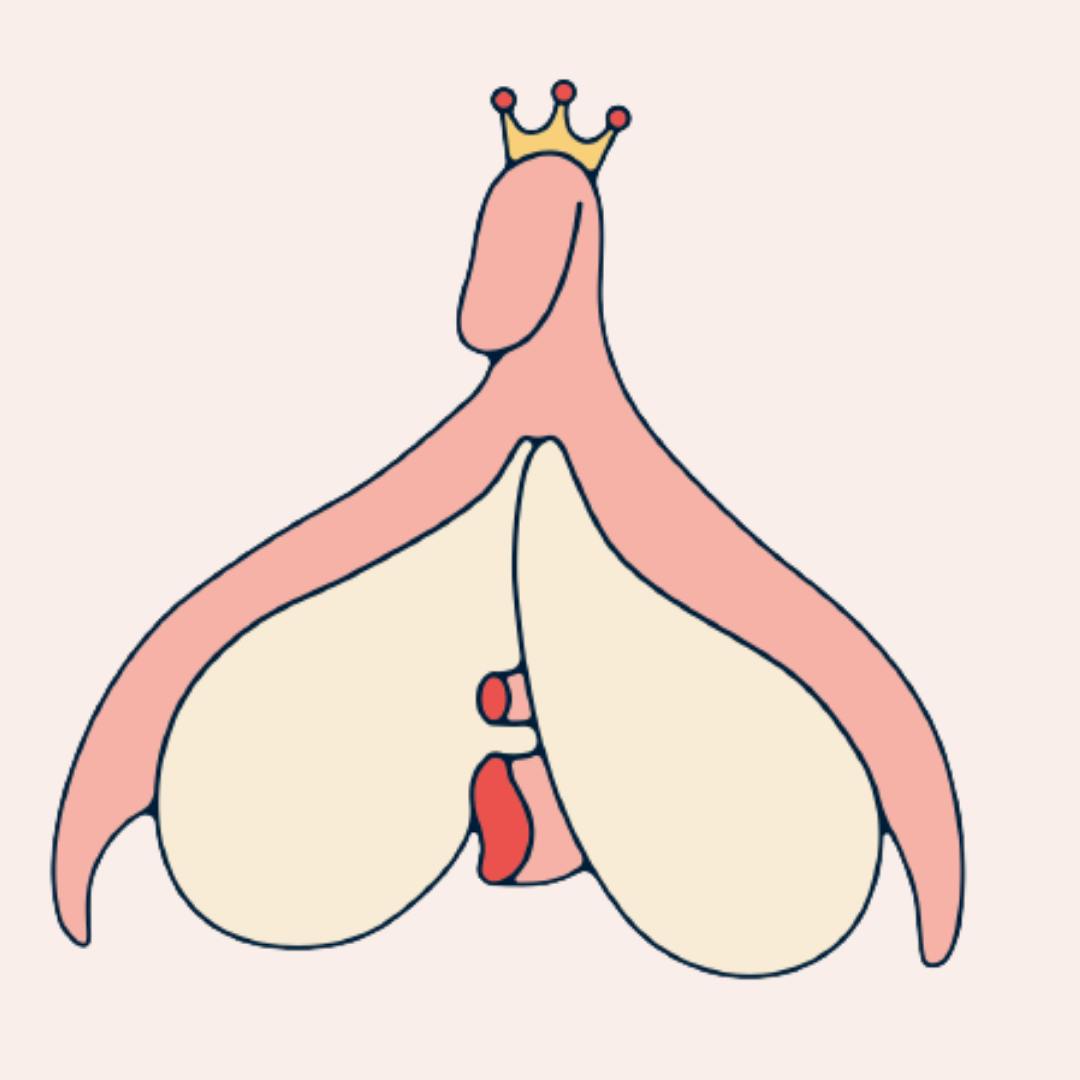Illustrated by Erin Rommel & Sabrina Bezerra
When I ask 27-year old Alice* if she’s ever reached orgasm with a sexual partner, her answer is unequivocal. “God, no,” she says, bluntly. “Never. Not once, ever.”
Alice, who identifies as straight, can orgasm alone — she has a dildo and a Rabbit, and can reach a climax either from penetration or clitoral stimulation (though she prefers the clitoral route) — but never with someone else in the room. She feels “uptight” when having sex, which she caveats with the fact that she hasn’t been in a long-term relationship; but maintains that this doesn’t automatically explain away her lack of orgasm when with a sexual partner. “I always feel like I need to make sure [the guy] finishes, so I’m actually way more wound up about that than [about] my own orgasm. [And when] I don’t orgasm, the men never ask why.”
Alice’s experience can be put down to one very simple phenomenon: the orgasm gap.
“The orgasm gap refers to the difference in the quantity of orgasms between couples,” says Relate-qualified Sex & Relationship Expert Rhian Kivits. “It’s also been used to compare demographics such as the difference in quantity of orgasms between heterosexual women, and lesbian and bisexual women, for example.” Clinical sexologist and Sex and Relationship Coach Ness Cooper further zeroes in on where the orgasm gap can commonly be made glaringly apparent, describing it as a “divide in sexual pleasure, often seen as those with penises reaching orgasm more [frequently] than those with vaginas.”

Alice says she feels “cheated out of” reaching orgasm with a partner, and adds that, “I find it annoying that I haven’t ever come with a guy. I’ve never felt like the priority, or even equal to them, [when I’ve had penetrative sex]. It’s always been about how to get to their ‘finale’, rather than mine. I [have a feeling] it would be really great if I [came] with a partner, but it’s never happened.”
Rachel*, 28, has never orgasmed with a sexual partner either (though, like Alice, she points out that she hasn’t yet been in a long-term relationship) — but she, too, can orgasm by herself, with the help of her three vibrators. She puts the orgasm gap down to the myriad ways in which female sexual pleasure can be reached, compared to that of men. “It’s not a ‘one size fits all’ approach for women,” she explains. “What worked with one partner doesn’t work with another. For example, I can’t orgasm from someone going down on me; but the opposite could be the case for another woman.”
“
It’s not a ‘one size fits all’ approach for women
One size fits all, it is certainly not. Contrary to what we so often see depicted on screen — lavish sex scenes (often between heterosexual, cisgender couples) with women throwing their heads back in blissful ecstasy before emitting that rapturous cry that viewers can safely interpret as a female orgasm (not to mention mainstream porn, which has long presented a highly unrealistic and damaging portrayal of female sexual pleasure) — the female orgasm is not often easily reached.
As indicated by Alice and Rachel’s experiences, the orgasm gap is widespread. Multiple studies have often learned of a gendered pleasure gap, with one review highlighting the “cultural prioritization of penile-vaginal intercourse over more clitorally focused sexual activities” being a pivotal driver. The orgasm gap also seems to be at its widest for (though is by no means restricted to) heterosexual couples: one US analysis found that 95% of heterosexual men said they usually-almost orgasmed when sexually intimate, followed by 89% of gay men, 88% of bisexual men, 86% of gay women, 66% of bisexual women and 65% of heterosexual women.

So how can we begin to close this all-too-prevalent orgasm gap? Well, the first step is to explore — and become better educated in — the multiple types of orgasm that women can experience, which include vaginal, clitoral and anal orgasms.
“Vaginal orgasms through penetration can be for a number of reasons,” says Cooper. “The anterior wall of the vagina has an area referred to as the ‘G-spot’; for some, when pressure is applied to this spot, it can lead to an orgasm. Some individuals have what are known as ‘Skene’s glands’ [in this area], and stimulating these can result in pleasure.
“Clitoral orgasms [can result from] stimulation of hands or oral sex,” Cooper continues; and Kivits describes anal orgasms as resulting from “indirect stimulation of an area within the vagina called the AFE zone, but also through stimulation of the perineum.”
Not only are there several types of female orgasm, but there are several routes available to get there, too, which will vary largely according to individuals.
“
I always recommend that women start with self-exploration
Sophie, 28, can only orgasm from clitoral stimulation; but she’s found that there are multiple routes through which she can get there. For example, she can reach orgasm both with a partner and on her own. “I have sex a lot at the moment — up to [roughly] five or six times a week — with a fairly new partner, and he always tries to make me orgasm,” she tells me. “It doesn’t always happen; sometimes if we’ve been drinking it makes it harder, sometimes because he’s still learning what works for me, sometimes I think I’m just too ‘in my head’. But it always feels good; and it’s usually more enhanced when there’s more going on than just clitoral stimulation, like if I’m giving head at the same time.”
When it comes to solo orgasms, Sophie can get there via several routes. “I can do it in the dark with my thoughts, or I can watch porn, or use toys, or a combination,” she explains.
The routes to orgasm continue. Alice, for example, often reads erotica to get herself “in the mood”, and plays with changing the settings on her vibrator. “I’ll often try to reach orgasm and then [edge myself]: where you edge towards orgasm and then stop yourself. [For me,] that’s a great [way to reach orgasm].”
Rachel, by turn, orgasms “95% of the time” through clitorial stimulation. “I start at the top of the clit, and then move down to the right,” she tells me. “I feel it across my whole body, but mostly in my stomach.”
One study that explored sociocultural influences on orgasm frequency together with the sexual satisfaction of women found that, “sexual assertiveness was the variable that positively correlated with and predicted orgasm frequency”; and suggested, “this indicates that socializing women to be more sexually assertive could potentially lead to more frequent orgasms and greater sexual satisfaction.”
I disagree. Of course, it can only be a positive thing for women to feel more sexually assertive and able to tell their sexual partners what will help them reach orgasm; but suggesting that women need to be socialized to orgasm more frequently simply places the sole burden on the women in question. In reality, men can be socialized, too: socialized to consider prioritising female sexual pleasure as the norm, and socialized to educate themselves about the multiple types of orgasm and the myriad — often unique — routes there are to get there, together with committing to close the pleasure gap. “It’s about teamwork,” says Alice.

Nevits echoes this. “It’s true that it helps when women empower themselves with knowledge about their bodies, ownership of their sexual pleasure and their sexual voice; but it’s also important for men to understand that the way they’ve been used to having sex isn’t the only way, and that it might not be the best way for their partners,” she emphasises.
But for any women who are looking to achieve orgasm more frequently — whether as a result of asserting yourself sexually (especially with new or one-time-only partners, when it can be harder to articulate what you need) or simply discovering what you like and what works for you — Nevits and Cooper both have some valuable advice.
“I always recommend that women start with self-exploration,” says Nevits. “There are erogenous zones all over the body, and becoming curious about this helps women learn how they can build arousal before they engage in direct genital stimulation.”
Cooper has several suggestions for women seeking to close the pleasure gap on a personal level. “Explore sex toys, from vibrators to suction devices,” advises Cooper. “These can help encourage blood flow to the genitals and make it easier to feel stimulation. Understanding that our sexual likes and dislikes can change and be fluid can help, too. Audio porn [and erotic books] can help excite some individuals and lead to heightened arousal.”
Both Cooper and Nevits also emphasize that orgasm and female sexual pleasure aren’t always synonymous, with Nevits pointing out that orgasm “isn’t the only way we can experience pleasure”, and we “have to be very appreciate of sexual difference and understand that there isn’t a standard or norm we’re supposed to be meeting”.
Cooper agrees. “Understanding that sexual pleasure doesn’t have to result in orgasm is important, and can help individuals to relax into other forms of pleasure that their body enjoys,” she explains.
Orgasm certainly isn’t the be-all-and-end-all; but the orgasm gap remains nonetheless. Alice says she imagines an orgasm with a partner to be “pretty fantastic”. Whether or not that will turn out to be true is anyone’s guess; but everyone deserves to find out.
*Names have been changed






